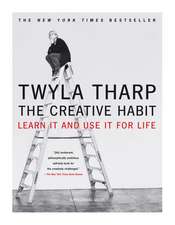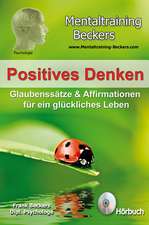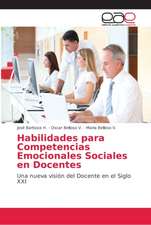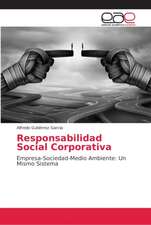Keep It Moving: Lessons for the Rest of Your Life: Bestselling Self-Help
Autor Twyla Tharpen Limba Engleză Paperback – 18 feb 2021
One of the world’s legendary artists and bestselling author of The Creative Habit shares her secrets—from insight to action—for harnessing vitality, finding purpose as you age, and expanding one’s possibilities over the course of a lifetime in her newest New York Times bestseller Keep It Moving.
At seventy-eight, Twyla Tharp is revered not only for the dances she makes—but for her astounding regime of exercise and nonstop engagement. She is famed for religiously hitting the gym each morning at daybreak, and utilizing that energy to propel her breakneck schedule as a teacher, writer, creator, and lecturer. This book grew out of the question she was asked most frequently: “How do you keep working?”
Keep It Moving is a series of no-nonsense mediations on how to live with purpose as time passes. From the details of how she stays motivated to the stages of her evolving fitness routine, Tharp models how fulfillment depends not on fortune—but on attitude, possible for anyone willing to try and keep trying. Culling anecdotes from Twyla’s life and the lives of other luminaries, each chapter is accompanied by a small exercise that will help anyone develop a more hopeful and energetic approach to the everyday.
Twyla will tell you what the beauty-fitness-wellness industry won’t: chasing youth is a losing proposition. Instead, Keep It Moving focuses you on what’s here and where you’re going—the book for anyone who wishes to maintain their prime for life.
Preț: 68.21 lei
Preț vechi: 122.45 lei
-44% Nou
Puncte Express: 102
Preț estimativ în valută:
13.05€ • 13.49$ • 10.86£
13.05€ • 13.49$ • 10.86£
Carte disponibilă
Livrare economică 07-19 martie
Livrare express 15-21 februarie pentru 80.13 lei
Preluare comenzi: 021 569.72.76
Specificații
ISBN-13: 9781982101312
ISBN-10: 1982101318
Pagini: 192
Ilustrații: 2-C throughout
Dimensiuni: 178 x 229 x 13 mm
Greutate: 0.39 kg
Editura: Simon&Schuster
Colecția Simon & Schuster
Seria Bestselling Self-Help
ISBN-10: 1982101318
Pagini: 192
Ilustrații: 2-C throughout
Dimensiuni: 178 x 229 x 13 mm
Greutate: 0.39 kg
Editura: Simon&Schuster
Colecția Simon & Schuster
Seria Bestselling Self-Help
Notă biografică
Twyla Tharp, one of America’s greatest choreographers began her career in 1965, and has created more than 130 dances for her company as well as for the Joffrey Ballet, the New York City Ballet, the Paris Opera Ballet, London’s Royal Ballet, Denmark’s Royal Ballet, and American Ballet Theatre. She has won two Emmy Awards for television’s Baryshnikov by Tharp, and a Tony Award for the Broadway musical Movin’ Out. The recipient of a MacArthur Fellowship, she was inducted into the American Academy of Arts & Sciences in 1993 and was made an honorary member of the American Academy of Arts and Letters in 1997. She holds nineteen honorary degrees, most recently from Harvard University. She lives and works in New York City.
Extras
Chapter 1: Terms and Conditions
Twenty years ago, I wrote a book called The Creative Habit, sharing the message that we can all live creative lives if only we could stop waiting for a muse to arrive with divine inspiration and instead just get down to work. In other words, you too can be more creative if you are willing to sweat a little. This message still resonates when I lecture. But, interestingly, the question I am most often asked after a talk these days is on a different topic entirely: “How do you keep working?” The subtext here, sotto voce, is “… at your age?” Which is seventy-eight.
To me it is simple. I continue to work as I always have, expecting each day to build on the one before. And I do not see why I should not continue to work in this spirit.
Keep It Moving is intended to encourage those who wish to maintain their prime a very long time. Like most books of practical advice, it identifies a “disease” and offers a cure. That disease, simply put, is our fear of time passing and the resulting aging process. The remedy? The book in your hands.
I flirted with the idea of calling this book The Youth Habit. I liked the suggestion that youth’s virtues could be easily transplanted into our post-youth years if only we followed a routine: take the stairs, use sunscreen, ingest more omega-3s and fewer omega-6s, don’t shortchange yourself on sleep. Cut out sugar, do something nice for someone else daily, floss, read more, watch less, love the one you’re with, and it’s okay to drink wine (until the next study says it isn’t). Sounded like a bestseller to me.
But if experience has taught me anything, it’s that chasing youth is a losing proposition. There’s little benefit in looking back, at least not with yearning or nostalgia or any other melancholy humor. To look back is to cling to something well over and behind you. We don’t lose youth. Youth stays put. We move on. We need to face the fact that aging will happen to us along with everybody else and just get on with it. Growing older is a strange stew of hope, despair, courage—still I think you will agree—it is light-years ahead of the alternative.
I don’t promise eternal youth in Keep It Moving. I have no interest in sugarcoating the aging process. What I believe in is change and the vitality it brings. Vitality means moving through life with energy and vigor, making deliberate choices and putting to good use the time and energy that we have been granted. You have, no doubt, seen people in their late seventies or even into their nineties who don’t seem worn out by their years but instead welcome the opportunity to be truly present in their bodies and in their minds. Instead of stubbornly staying on known paths, afraid to stray, they look at what comes next with curiosity, expanding into whatever it may be.
So, no, this book is not The Youth Habit. Nor is it The Creative Habit—which promotes regularity in living and working—because as we grow older, it is just as important to break habits as it is to make them.
I want to reprogram how you think about aging by getting rid of two corrosive ideas. First, that you need to emulate youth, resolving to live in a corner of the denial closet marked “reserved for aged.” Second, that your life must contract with time. Let’s start by breaking some old thought patterns.
I’ve danced my entire life (and still do) and I’ve spent time with many great performers. For these dancers and athletes, the passage of time presents mostly difficult realities. The jump declines, speed diminishes, flexibility is challenged. And fear of decline and irrelevance starts early.
Years ago, I was sitting in a coffee shop with a dancer of remarkable talents, Mikhail Baryshnikov. We had just finished one of the early rehearsals for Push Comes to Shove, a ballet I wrote for him. Even then it was clear that he was a phenomenon, one of the very greatest classical dancers of the twentieth century. Though he was in his prime, he was looking morose as we drank our coffee. I asked him, “Misha, what’s the matter? You don’t like what we’re doing?” No, he said, he loved what we were doing; “But,” he added, “soon we will be old.” He was all of twenty-seven. And yet I understood.
For dancers, aging is ever in front of us as we work. We face it each time we enter the studio, one day older than the day before. But who among us in the civilian population has not shared the feeling that they, too, will be finished by forty? It needles when things don’t work the way they used to. And it doesn’t help that, gradually, as joints begin to ache and memory to slip, we are bombarded by negative messages from our culture. Older adults are frequently portrayed as out of touch, useless, feeble, incompetent, pitiful, and irrelevant. Sadly, these dismal expectations can become self-fulfilling, creating the bias that fuels our roaring age industry—pills, diets, special cosmetics, surgery—all promising to send time reeling backward. But no. Time goes only one way: forward.
The result? Frustration becomes a habit. Little indignities become a reason to rant and complain. But that scenario will bleed out your spirit, take away your resiliencies. If you go into situations always expecting to be cheated or deprived, you’ll likely find ways to tell yourself that is exactly what has happened. Don’t go searching for things that confirm or fuel your sense of indignation. It will become a default mind-set promoting more of the same.
Let’s agree:
Age is not the enemy. Stagnation is the enemy. Complacency is the enemy. Stasis is the enemy. Attempting to maintain the status quo, smoothing our skin, and keeping our tummies trim become distractions that obscure a larger truth. Attempting to freeze your life in time at any point is totally destructive to the prospect of a life lived well and fully. All animate creatures are destroyed when frozen. They do not move. This is not a worthy goal.
However, the forces that create inertia in our lives are difficult to resist for they are hardwired into us. People prefer to keep going along as they always have rather than make a decision that would knock them out of their groove, even when it would be relatively easy to change course. Behavioral scientists refer to this as status quo bias. We succumb to this bias with habits large and small, from an inability to give up our three cups of coffee a day to staying with a partner long after it’s clear that the relationship is over. The devil best known becomes our buddy.
Along with status quo bias, there is another habit I’d like to undo. As we get older and our bodies enjoy less natural freedom of movement, we tend to take up less space, both physically and metaphorically. Here’s the endpoint of this tendency: our backs arch forward, no longer straight and long. Our steps shorten from a stride to a shuffle. Our vision narrows, slowly erasing the periphery, leaving only what’s in front of our nose. No wonder we prefer remaining at home, our life lived in fewer and fewer rooms. We let our bodies constrict, inviting the world around us to close in.
The mind will follow the body’s contraction. On this path, our concerns narrow down to the most elemental functions: what to eat, getting enough sleep, keeping an appointment.
Contraction is not inevitable. You can resist and reverse.
Now to form some new habits. I hope in these pages to get you to wake up and move more. After all, I repeat, to move is the provenance of all living human beings. And by my definition, to move is to dance. With the time you’ve got, choose to make your life bigger. Opt for expression over observation, action instead of passivity, risk over safety, the unknown over the familiar. Be deliberate, act with intention. Chase the sublime and the absurd. Make each day one where you emerge, unlock, excite, and discover. Find new, reconsider old, become limber, stretch, lean, move … I say this with love: shut up and dance. That was the advice I gave myself for my sixty-fifth birthday. You might want to start now.
I will try to help. Each chapter includes an approach to moving that can be practiced by the beginner as well as the advanced. These exercises are reflective of simple actions we all use every day. Begin now.
TAKE UP SPACE
When your muscles stretch rather than constrict, you expand your share of the planet. You take up more space, not less. Dancers know this intuitively. They are taught to move so that every gesture is not only more precise and elegant but bigger. We call it amplitude. It is not enough to state an arabesque; it must be opened in every direction to its full expanse. In order to be seen, the dancer must occupy maximum volume. You can think the same way in your everyday movements.
There is logic in our movement. Remember, when we walk, we go forward. We can move backward, but we are not designed for this. Forward is our natural way.
Think of this all as your personal Occupy More Space protest.
With this in mind, consider what would happen if you continued to conduct your life beyond forty-five to arrive at seventy-five as a powerful beginning point, where, honed and strengthened by experience, you could use a lifetime’s efforts to give yourself new options in both how you address work and how you live with those you love. Why not insist on continuing to make fundamental choices for yourself, not leaving it to chance and “how things will be”? Why not evaluate your accomplishments as beginnings rather than endings.
Amass the experiences and grow into the person you were meant to be. One of the first lessons in the studio is that if you want to be something, you’ve got to train to be it over and over. Master cellist Pablo Casals was asked late in life, “Why practice at age ninety-one?” “Because I am making progress” was his answer. Right!
Practice growth. This is one habit I encourage you to cultivate. What you do today is an investment in tomorrow. With that in mind, to the list of desirable states of emotional equilibrium that end in “-ness”—for example, wellness, mindfulness, forgiveness, friendliness, decisiveness, hopefulness, and the really big one, happiness—let me add a personal favorite: expansiveness. Moving out is moving on, time and space working in tandem. Expansiveness is a factor of the following four ingredients:
If we can husband and direct our time and energy, the quality of each day or year will spring from a marriage of intention and disciplined effort rather than a reliance on luck or genetic birthright. We make a choice. We invest our time and energy. We reap the reward or take the hit. Whatever the result, we are constantly working on what comes next. We earn our life.
Make a contract with your future. Facing new habits requires accountability. Here are the terms and conditions of our agreement:
What I want us to do is abandon our infatuation with the status quo and jettison our aversion to every form of risk, acknowledge we are getting older; pledge to get over it and get moving.
That’s the deal. Turn the page.
Twenty years ago, I wrote a book called The Creative Habit, sharing the message that we can all live creative lives if only we could stop waiting for a muse to arrive with divine inspiration and instead just get down to work. In other words, you too can be more creative if you are willing to sweat a little. This message still resonates when I lecture. But, interestingly, the question I am most often asked after a talk these days is on a different topic entirely: “How do you keep working?” The subtext here, sotto voce, is “… at your age?” Which is seventy-eight.
To me it is simple. I continue to work as I always have, expecting each day to build on the one before. And I do not see why I should not continue to work in this spirit.
Keep It Moving is intended to encourage those who wish to maintain their prime a very long time. Like most books of practical advice, it identifies a “disease” and offers a cure. That disease, simply put, is our fear of time passing and the resulting aging process. The remedy? The book in your hands.
I flirted with the idea of calling this book The Youth Habit. I liked the suggestion that youth’s virtues could be easily transplanted into our post-youth years if only we followed a routine: take the stairs, use sunscreen, ingest more omega-3s and fewer omega-6s, don’t shortchange yourself on sleep. Cut out sugar, do something nice for someone else daily, floss, read more, watch less, love the one you’re with, and it’s okay to drink wine (until the next study says it isn’t). Sounded like a bestseller to me.
But if experience has taught me anything, it’s that chasing youth is a losing proposition. There’s little benefit in looking back, at least not with yearning or nostalgia or any other melancholy humor. To look back is to cling to something well over and behind you. We don’t lose youth. Youth stays put. We move on. We need to face the fact that aging will happen to us along with everybody else and just get on with it. Growing older is a strange stew of hope, despair, courage—still I think you will agree—it is light-years ahead of the alternative.
I don’t promise eternal youth in Keep It Moving. I have no interest in sugarcoating the aging process. What I believe in is change and the vitality it brings. Vitality means moving through life with energy and vigor, making deliberate choices and putting to good use the time and energy that we have been granted. You have, no doubt, seen people in their late seventies or even into their nineties who don’t seem worn out by their years but instead welcome the opportunity to be truly present in their bodies and in their minds. Instead of stubbornly staying on known paths, afraid to stray, they look at what comes next with curiosity, expanding into whatever it may be.
So, no, this book is not The Youth Habit. Nor is it The Creative Habit—which promotes regularity in living and working—because as we grow older, it is just as important to break habits as it is to make them.
I want to reprogram how you think about aging by getting rid of two corrosive ideas. First, that you need to emulate youth, resolving to live in a corner of the denial closet marked “reserved for aged.” Second, that your life must contract with time. Let’s start by breaking some old thought patterns.
I’ve danced my entire life (and still do) and I’ve spent time with many great performers. For these dancers and athletes, the passage of time presents mostly difficult realities. The jump declines, speed diminishes, flexibility is challenged. And fear of decline and irrelevance starts early.
Years ago, I was sitting in a coffee shop with a dancer of remarkable talents, Mikhail Baryshnikov. We had just finished one of the early rehearsals for Push Comes to Shove, a ballet I wrote for him. Even then it was clear that he was a phenomenon, one of the very greatest classical dancers of the twentieth century. Though he was in his prime, he was looking morose as we drank our coffee. I asked him, “Misha, what’s the matter? You don’t like what we’re doing?” No, he said, he loved what we were doing; “But,” he added, “soon we will be old.” He was all of twenty-seven. And yet I understood.
For dancers, aging is ever in front of us as we work. We face it each time we enter the studio, one day older than the day before. But who among us in the civilian population has not shared the feeling that they, too, will be finished by forty? It needles when things don’t work the way they used to. And it doesn’t help that, gradually, as joints begin to ache and memory to slip, we are bombarded by negative messages from our culture. Older adults are frequently portrayed as out of touch, useless, feeble, incompetent, pitiful, and irrelevant. Sadly, these dismal expectations can become self-fulfilling, creating the bias that fuels our roaring age industry—pills, diets, special cosmetics, surgery—all promising to send time reeling backward. But no. Time goes only one way: forward.
The result? Frustration becomes a habit. Little indignities become a reason to rant and complain. But that scenario will bleed out your spirit, take away your resiliencies. If you go into situations always expecting to be cheated or deprived, you’ll likely find ways to tell yourself that is exactly what has happened. Don’t go searching for things that confirm or fuel your sense of indignation. It will become a default mind-set promoting more of the same.
Let’s agree:
Age is not the enemy. Stagnation is the enemy. Complacency is the enemy. Stasis is the enemy. Attempting to maintain the status quo, smoothing our skin, and keeping our tummies trim become distractions that obscure a larger truth. Attempting to freeze your life in time at any point is totally destructive to the prospect of a life lived well and fully. All animate creatures are destroyed when frozen. They do not move. This is not a worthy goal.
However, the forces that create inertia in our lives are difficult to resist for they are hardwired into us. People prefer to keep going along as they always have rather than make a decision that would knock them out of their groove, even when it would be relatively easy to change course. Behavioral scientists refer to this as status quo bias. We succumb to this bias with habits large and small, from an inability to give up our three cups of coffee a day to staying with a partner long after it’s clear that the relationship is over. The devil best known becomes our buddy.
Along with status quo bias, there is another habit I’d like to undo. As we get older and our bodies enjoy less natural freedom of movement, we tend to take up less space, both physically and metaphorically. Here’s the endpoint of this tendency: our backs arch forward, no longer straight and long. Our steps shorten from a stride to a shuffle. Our vision narrows, slowly erasing the periphery, leaving only what’s in front of our nose. No wonder we prefer remaining at home, our life lived in fewer and fewer rooms. We let our bodies constrict, inviting the world around us to close in.
The mind will follow the body’s contraction. On this path, our concerns narrow down to the most elemental functions: what to eat, getting enough sleep, keeping an appointment.
Contraction is not inevitable. You can resist and reverse.
Now to form some new habits. I hope in these pages to get you to wake up and move more. After all, I repeat, to move is the provenance of all living human beings. And by my definition, to move is to dance. With the time you’ve got, choose to make your life bigger. Opt for expression over observation, action instead of passivity, risk over safety, the unknown over the familiar. Be deliberate, act with intention. Chase the sublime and the absurd. Make each day one where you emerge, unlock, excite, and discover. Find new, reconsider old, become limber, stretch, lean, move … I say this with love: shut up and dance. That was the advice I gave myself for my sixty-fifth birthday. You might want to start now.
I will try to help. Each chapter includes an approach to moving that can be practiced by the beginner as well as the advanced. These exercises are reflective of simple actions we all use every day. Begin now.
TAKE UP SPACE
When your muscles stretch rather than constrict, you expand your share of the planet. You take up more space, not less. Dancers know this intuitively. They are taught to move so that every gesture is not only more precise and elegant but bigger. We call it amplitude. It is not enough to state an arabesque; it must be opened in every direction to its full expanse. In order to be seen, the dancer must occupy maximum volume. You can think the same way in your everyday movements.
- When you walk, think of yourself striding, not just taking mingy steps.
- Greeting a friend, reach your arm out, whether to shake a hand or give a hug, with amplitude and full fellow feeling. Be robust.
- During a meeting, spread your belongings out across the table instead of gathering them tidily in your lap. Speak out. Take up mental space as well.
There is logic in our movement. Remember, when we walk, we go forward. We can move backward, but we are not designed for this. Forward is our natural way.
Think of this all as your personal Occupy More Space protest.
With this in mind, consider what would happen if you continued to conduct your life beyond forty-five to arrive at seventy-five as a powerful beginning point, where, honed and strengthened by experience, you could use a lifetime’s efforts to give yourself new options in both how you address work and how you live with those you love. Why not insist on continuing to make fundamental choices for yourself, not leaving it to chance and “how things will be”? Why not evaluate your accomplishments as beginnings rather than endings.
Amass the experiences and grow into the person you were meant to be. One of the first lessons in the studio is that if you want to be something, you’ve got to train to be it over and over. Master cellist Pablo Casals was asked late in life, “Why practice at age ninety-one?” “Because I am making progress” was his answer. Right!
Practice growth. This is one habit I encourage you to cultivate. What you do today is an investment in tomorrow. With that in mind, to the list of desirable states of emotional equilibrium that end in “-ness”—for example, wellness, mindfulness, forgiveness, friendliness, decisiveness, hopefulness, and the really big one, happiness—let me add a personal favorite: expansiveness. Moving out is moving on, time and space working in tandem. Expansiveness is a factor of the following four ingredients:
- Intention is the umbrella term for our desires, ambitions, and designs for the future. Intention defines our next move, and the next, and the one after that. It’s how we plan and control our life. Without it, we’re either marching in place or losing ground.
- Honest appraisal of the past is how we deal with the inevitable setbacks, failures, and embarrassments life hands us. Without it, we cannot self-correct or recover. We will be forever mired in regret and guilt, wanting to change what we’ve already done to create a new outcome. Only happens in science fiction.
- Anger about the past is the killer emotion. It’s noise not signal. Crank it up to high volume and it cancels out the sound of our best intentions.
- Energy and time are self-explanatory, but as tools they are force multipliers. If you have an abundance of time and energy but waste it by getting stuck in the stale routines of the past, you have no chance of moving forward.
If we can husband and direct our time and energy, the quality of each day or year will spring from a marriage of intention and disciplined effort rather than a reliance on luck or genetic birthright. We make a choice. We invest our time and energy. We reap the reward or take the hit. Whatever the result, we are constantly working on what comes next. We earn our life.
Make a contract with your future. Facing new habits requires accountability. Here are the terms and conditions of our agreement:
- Acknowledge you have choices. Make them.
- Your body will be a big part of this deal and you will be ready and able to use it.
- You will be okay to reidentify yourself often along the way.
- Obstacles—you will meet many—go around, over, under, or through. Again often.
- Bounce back—yes, many, many times.
- Up is preferred to down.
- Stamina is your bailiwick. Train. Train more.
- Bend in the wind.
- Get stronger for the mending.
- Dance is being in motion. You are doing it. Do it more.
What I want us to do is abandon our infatuation with the status quo and jettison our aversion to every form of risk, acknowledge we are getting older; pledge to get over it and get moving.
That’s the deal. Turn the page.
Descriere
One of the world’s legendary artists shares her secrets—from insight to action—for harnessing vitality, finding purpose as you age.











